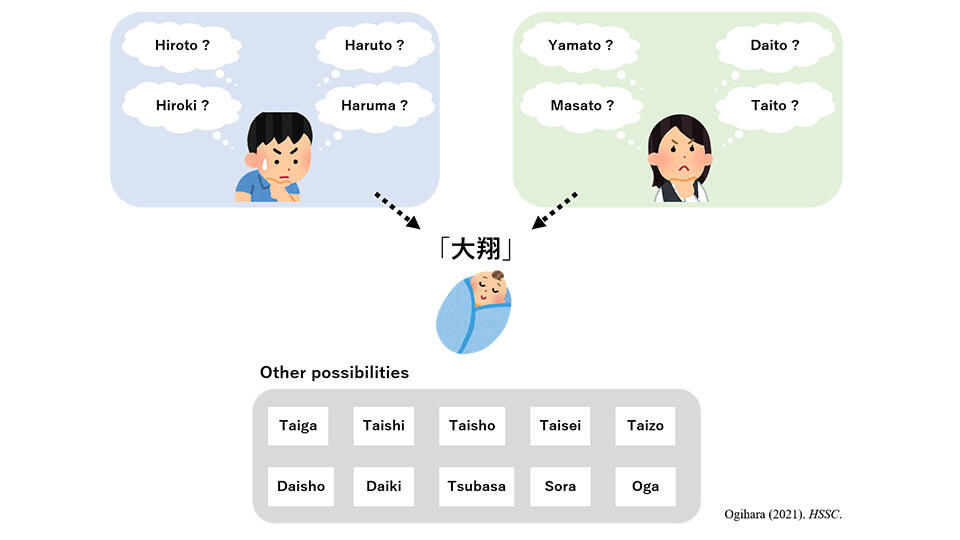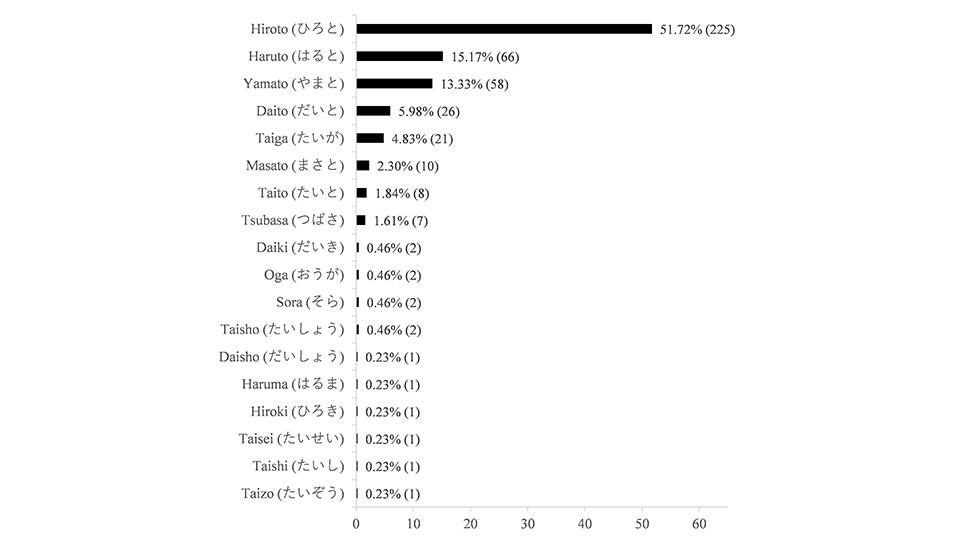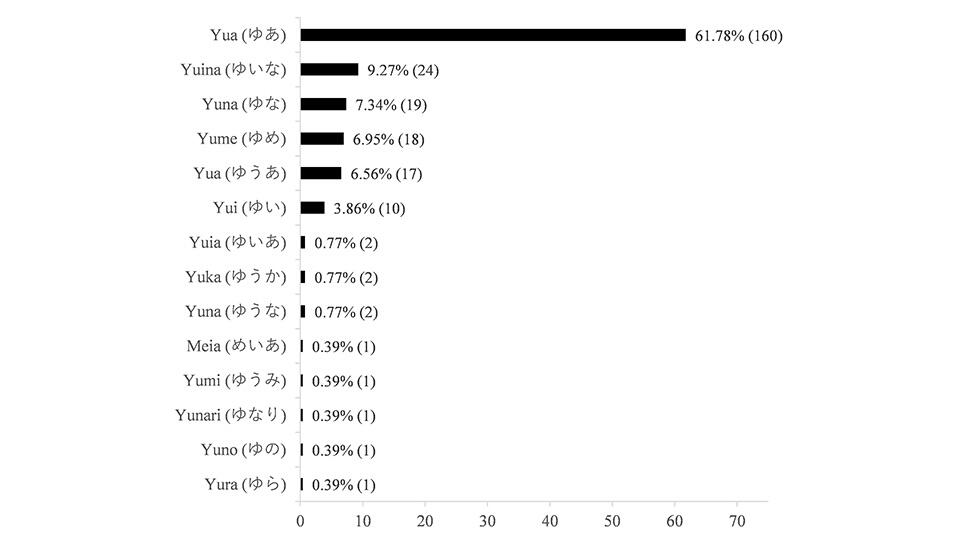2021.07.29 Thursday
I Know the Name, But Cannot Read It Right: Difficulties in Reading Recent Japanese Names
In a new study, a researcher finds that there are 18 ways to read the common boys' name "大翔," and 14 ways to read the common girls' name "結愛"
Assistant Professor Yuji Ogihara analyzed the readings of the names of infants born recently in Japan. He discovered 18 ways to read the common name "大翔" and 14 ways to read the common name "結愛," proving that it is difficult even for native Japanese speakers to correctly read the names of newborns. His research contributes to the understanding of naming practices in Japan as well as the entire Sinosphere.
 Figure 1. Summary of results |
It has been pointed out that recent Japanese names are difficult to read correctly at first sight, even for native Japanese speakers. However, studies on this subject so far have only examined distinctive names, and the manner and extent to which it is difficult to read them has not been sufficiently examined.
One reason for this difficulty is that there are no limits on the character readings that can be used in names, thus greatly increasing unique readings of names in addition to the common ones. This is different from China, where readings for most characters are fixed. It is also different from the language spheres (English, Spanish, German, etc.) that use phonograms like alphabets in which letters and sounds are paired one-to-one. The large number of options in character readings is making it much harder to correctly read names.
To investigate this phenomenon, Assistant Professor Yuji Ogihara from the Tokyo University of Science analyzed approximately 8,000 names of infants born between 2004 and 2018 obtained from the database of a life insurance company. He first chose four recent common names for boys and girls each (Boys: "大翔," "陽翔," "翔," "颯," Girls: "結愛," "陽菜," "愛," "杏") on the basis of popularity rankings for each year. He then comprehensively surveyed all their readings and calculated the ratio and number of ways to read each name. These results were published on June 21, 2021 in the international journal Humanities and Social Sciences Communications.
Assistant Professor Ogihara discovered that there are at least 18 ways to read "大翔" (Figure 2) and at least 14 ways to read "結愛" (Figure 3). Even single-character names like "颯," and "杏," had seven and five readings, respectively. The readings each differed greatly in pronunciation, length, and meaning. Assistant Professor Ogihara showed that the other names have many readings, too.
 Figure 2. Readings of "大翔" and their ratios (Scores indicate relative frequencies of each reading among the sample (n = 435). Scores in parentheses indicate the absolute frequencies of each reading.) |
 Figure 3. Readings of "結愛" and their ratios (Scores indicate relative frequencies of each reading among the sample (n = 259). Scores in parentheses indicate the absolute frequencies of each reading.) |
He further found that parents were not only using the common readings of each character, but also using readings that do not exist for a character or using a character for its meaning and imagery. For example, "大翔" was also read as "Tsubasa"(meaning "wing"). Neither "大" nor "翔" formally have "Tsubasa" as a reading. "翔" is read as "Tsubasa" because it has the meanings "flap" and "fly," and a reading associated with the imagery of the character is observed. The character "大" is given, but not pronounced, and the meaning "to flap broadly" is obtained. Hence, the character is only added for its imagery or meaning.
Assistant Professor Ogihara also saw a pattern of abbreviating common readings. For example, "大翔" was read as "Taishi." "大" has the reading "tai," and "翔" has the reading "shou." "Shou" was abbreviated to "shi" and combined with "tai." He also found instances where the meanings of characters are read in foreign languages. Take "結愛 Yura," for example. While "結" comes from the common reading "yu(u)," "愛" is generally not read as "ra," but because "愛" means "love" (rabu) in English, it is possible to omit the "bu" and use it as "ra."
In this study, Assistant Professor Ogihara systematically analyzed actual name data and empirically investigated the difficulty of correctly reading Japanese names. The investigation of these difficulties contributes to deepening our understanding of naming practices and the characteristics of names, not only in Japan, but in the Sinosphere, which includes East and Southeast Asia.
Reference
| Title of original paper | : | I Know The Name Well, But Cannot Read It Correctly: Difficulties in Reading Recent Japanese Names |
| Journal | : | Humanities and Social Sciences Communications |
| DOI | : | 10.1057/s41599-021-00810-0 (Open Access: Anyone can read it for free) |
About The Tokyo University of Science
Tokyo University of Science (TUS) is a well-known and respected university, and the largest science-specialized private research university in Japan, with four campuses in central Tokyo and its suburbs and in Hokkaido. Established in 1881, the university has continually contributed to Japan's development in science through inculcating the love for science in researchers, technicians, and educators.
With a mission of "Creating science and technology for the harmonious development of nature, human beings, and society", TUS has undertaken a wide range of research from basic to applied science. TUS has embraced a multidisciplinary approach to research and undertaken intensive study in some of today's most vital fields. TUS is a meritocracy where the best in science is recognized and nurtured. It is the only private university in Japan that has produced a Nobel Prize winner and the only private university in Asia to produce Nobel Prize winners within the natural sciences field.
About Assistant Professor Yuji Ogihara from Tokyo University of Science
Yuji Ogihara, Ph.D., is an Assistant Professor at the Institute of Arts and Sciences and the Faculty of Science Division II at the Tokyo University of Science in Japan. He earned his doctorate from Kyoto University in 2015. His research interests include cultural change, interpersonal relationships, happiness, individualism, and culture. He is a recipient of numerous awards, including the 2015 Student Poster Award (Society for Personality and Social Psychology), and has over 20 publications to his name.
https://www.tus.ac.jp/en/fac/p/index.php?6FD9 
https://sites.google.com/site/yujiogiharaweb/english 

